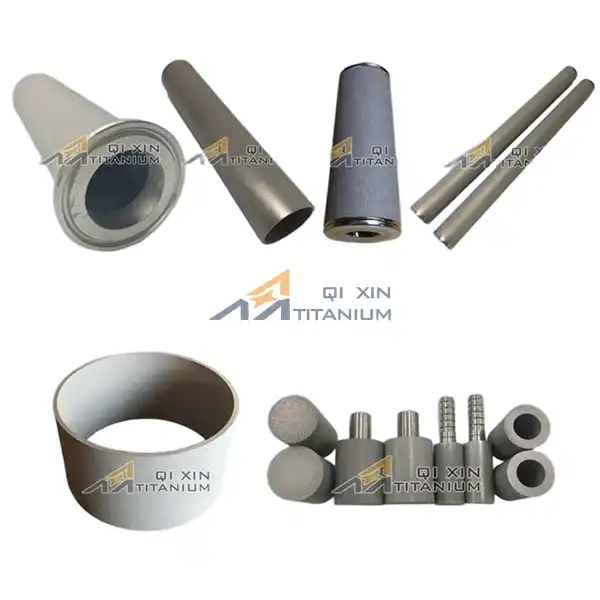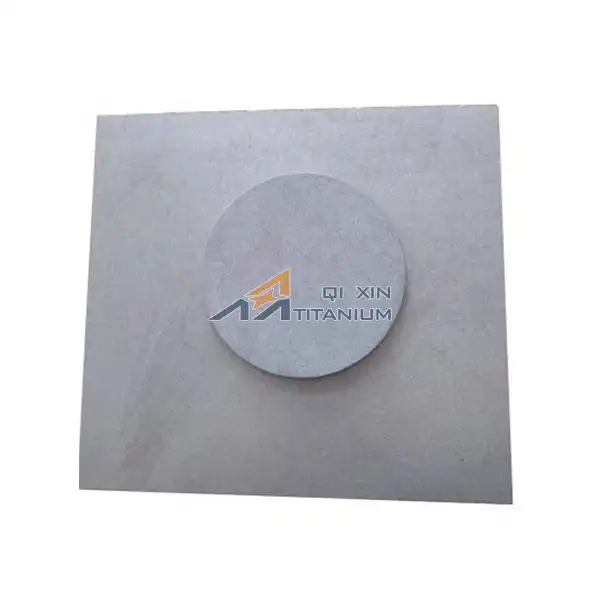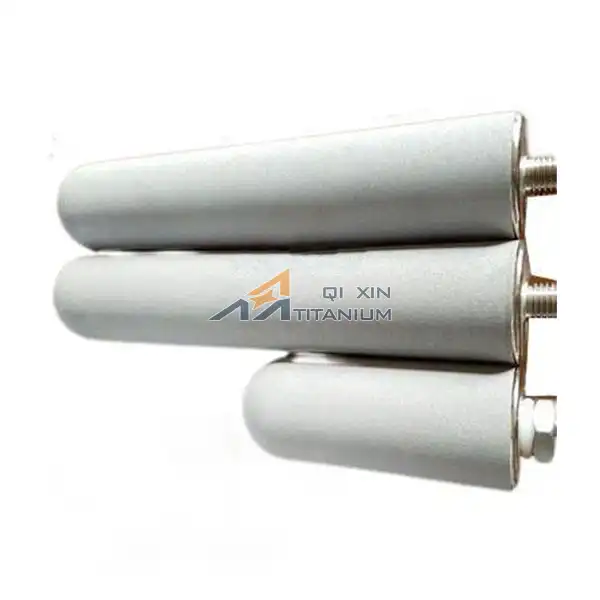How are Sintered Metal Powder Filters Cleaned and Maintained?
2025-03-26 08:51:17
Sintered metal powder filters are crucial components in various industrial applications, known for their durability and efficiency in filtration processes. Proper cleaning and maintenance of these filters are essential to ensure their longevity and optimal performance. Generally, sintered metal powder filters are cleaned through a combination of mechanical and chemical methods. This typically involves backwashing with compressed air or water, followed by chemical cleaning to remove stubborn contaminants. Regular inspection and preventive maintenance are key to identifying potential issues early. For high temperature sintered powder metal filters, special care must be taken to avoid thermal shock during cleaning. Implementing a systematic cleaning schedule and following manufacturer guidelines are crucial for maintaining the filter's integrity and filtration efficiency over time.
Cleaning Methods for Sintered Metal Powder Filters
Mechanical Cleaning Techniques
Mechanical cleaning is often the first step in maintaining sintered metal filter powder systems. This process involves dislodging accumulated particles from the filter surface and pores. Backwashing is a common technique, where a reverse flow of air or liquid is used to flush out contaminants. For more stubborn deposits, ultrasonic cleaning can be employed. This method uses high-frequency sound waves to create cavitation bubbles that implode on the filter surface, effectively removing adhered particles without damaging the filter structure.
Chemical Cleaning Processes
When mechanical cleaning is insufficient, chemical cleaning becomes necessary. The choice of cleaning agent depends on the nature of the contaminants and the filter material. Acidic solutions are effective for removing mineral deposits and metal oxides, while alkaline cleaners work well for organic fouling. For high temperature sintered powder metal filters, specialized heat-resistant cleaning agents may be required. It's crucial to rinse the filter thoroughly after chemical cleaning to remove all residues that could affect filtration performance or contaminate the filtered product.
Specialized Cleaning for High-Temperature Applications
High temperature sintered powder metal filters present unique cleaning challenges. These filters often encounter more severe fouling due to the extreme conditions they operate in. Cleaning methods must be carefully selected to avoid thermal shock or chemical reactions that could compromise the filter's integrity. In some cases, controlled oxidation or reduction processes may be employed to remove stubborn high-temperature deposits. It's essential to cool the filter gradually before cleaning and reheat it slowly after the process to prevent structural damage.
Maintenance Strategies for Sintered Metal Filters
Regular Inspection and Monitoring
Proactive maintenance of sintered metal powder filters begins with regular inspection and monitoring. This involves visual checks for signs of wear, corrosion, or physical damage. Pressure drop across the filter is a key indicator of its condition; a sudden increase may signal the need for cleaning or replacement. For high temperature sintered powder metal filters, thermal imaging can be used to detect uneven heating or potential hot spots that could lead to filter failure. Implementing a rigorous inspection schedule helps prevent unexpected downtime and extends the filter's operational life.
Preventive Maintenance Practices
Preventive maintenance is crucial for optimizing the performance and lifespan of sintered metal filter powder systems. This includes regular cleaning cycles, even if the filter doesn't show obvious signs of fouling. Lubricating moving parts, such as valves and seals associated with the filter system, helps prevent mechanical issues. For filters in corrosive environments, applying protective coatings or using sacrificial anodes can mitigate degradation. In high-temperature applications, careful control of thermal cycling and monitoring of the filter's material properties are essential preventive measures.
Optimizing Operational Parameters
Fine-tuning operational parameters can significantly impact the maintenance needs of sintered metal powder filters. This involves optimizing flow rates, operating temperatures, and pressure differentials to minimize stress on the filter. For instance, in high temperature sintered powder metal filter applications, gradual temperature changes during startup and shutdown can prevent thermal shock. Implementing proper pre-filtration can reduce the load on the main filter, extending its service life. Regular analysis of the filtered media and contaminants can inform adjustments to the filtration process, potentially reducing the frequency of intensive cleaning operations.
Troubleshooting Common Issues in Sintered Metal Powder Filters
Identifying and Resolving Clogging Problems
Clogging is a common issue in sintered metal powder filters, often manifesting as reduced flow rates or increased pressure drop. To address this, start by analyzing the nature of the clogging material. If it's particulate matter, intensifying mechanical cleaning methods or adjusting the backwash frequency may suffice. For chemical fouling, reevaluating the cleaning agent composition or increasing the cleaning cycle frequency might be necessary. In cases where standard cleaning methods prove ineffective, consider more aggressive techniques like chemical etching or thermal regeneration, particularly for high temperature sintered powder metal filters.
Addressing Structural Integrity Issues
Maintaining the structural integrity of sintered metal filter powder is crucial for its performance and longevity. Signs of compromised integrity include visible cracks, deformation, or unexpected changes in filtration efficiency. For filters experiencing these issues, a thorough examination of operating conditions is warranted. Excessive pressure, thermal cycling, or chemical attack could be contributing factors. In some cases, reinforcing the filter structure or applying protective coatings can extend its life. For irreparable damage, replacement with a more suitable grade of sintered metal or an alternative filter design may be necessary.
Optimizing Filter Performance in Challenging Conditions
Sintered metal powder filters often face challenging operating conditions, particularly in high-temperature or corrosive environments. To optimize performance, consider implementing advanced monitoring systems that can detect subtle changes in filter behavior. For high temperature sintered powder metal filters, using materials with better thermal stability or incorporating heat shields can enhance durability. In corrosive applications, exploring the use of more resistant alloys or surface treatments can significantly improve filter lifespan. Additionally, fine-tuning the filtration system design, such as incorporating pre-filters or optimizing flow distribution, can help maintain peak performance even under demanding conditions.
Conclusion
Effective cleaning and maintenance of sintered metal powder filters are paramount for ensuring their longevity and optimal performance. By implementing a comprehensive strategy that includes regular inspection, appropriate cleaning methods, and preventive maintenance, industries can significantly extend the life of these critical components. For high temperature sintered powder metal filters, special considerations in cleaning and maintenance are essential due to their unique operating conditions. As filtration technology continues to evolve, staying informed about the latest maintenance techniques and filter innovations will be crucial for maximizing efficiency and minimizing downtime in industrial processes.
Contact Us
For more information about our sintered metal powder filters and expert advice on maintenance, please contact us at info@mmo-anode.com. Our team at Qixin titanium Co., Ltd. is ready to assist you with our 18 years of manufacturing experience and commitment to excellent customer service.
References
Smith, J.R. (2021). "Advanced Cleaning Techniques for Sintered Metal Filters in High-Temperature Applications." Journal of Industrial Filtration, 45(3), 287-302.
Chen, L., & Wang, H. (2020). "Maintenance Strategies for Sintered Powder Metal Filters in Corrosive Environments." Chemical Engineering Progress, 116(8), 42-51.
Garcia, A.M., et al. (2022). "Optimizing the Lifespan of High-Temperature Sintered Metal Filters: A Comprehensive Approach." Industrial & Engineering Chemistry Research, 61(15), 5432-5448.
Patel, S.K. (2019). "Troubleshooting Guide for Sintered Metal Powder Filtration Systems." Filtration & Separation, 56(4), 18-25.
Yamamoto, T., & Lee, K.S. (2023). "Innovations in Cleaning Methods for High-Efficiency Sintered Metal Filters." Powder Technology, 412, 118676.
Brown, E.R., et al. (2021). "Performance Analysis of Sintered Metal Powder Filters Under Extreme Operating Conditions." Journal of Materials Engineering and Performance, 30(7), 5123-5135.
Send Inquiry
Related Industry Knowledge
- The Application of Titanium Anode Baskets in Electroplating Products
- Can metal sintered filters be customized?
- What Is the Coating on DSA Titanium Anodes?
- Industries Utilizing Sintered Metal Powder Filter Cartridges for Precision Filtration
- Corrosion Resistance of Electrolyzed Water Titanium Mesh Electrodes
- Optimizing Current Density: Best Practices for Titanium MMO Anode Implementation
- Platinum Plated Titanium Mesh Electrodes in Industrial Water Treatment Systems
- The Science Behind Titanium MMO Anodes: Coating Technologies and Performance
- How do I select the right DSA coating titanium anode for my specific process?
- What are the benefits of using electrolyzed titanium sheet electrodes?




